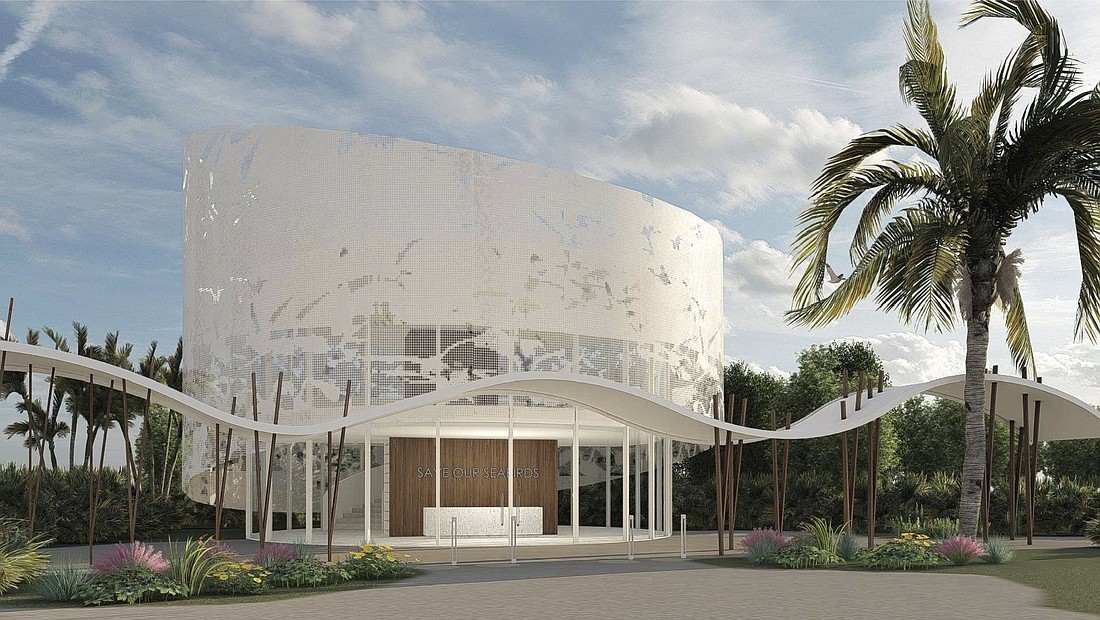- July 4, 2025
-
-
Loading

Loading

Save Our Seabirds last weekend announced a capital campaign designed to raise around $5 million to expand its existing grounds with an entry and education building, renewed rehabilitation facilities and a new educational, bird-themed playground.
First to be overhauled are the entry and education portions of the grounds. Currently, the entry to Save Our Seabirds is a stand at the front of the property, exposed to the elements. The education center is much the same; a pavilion in the sanctuary.
Proposed as replacements are the Anderson Pavilion and the Bergs-Steinwachs Education Center, a two-story glass building where the entryway and education center will be housed. The outside features aluminum etchings of birds on a screen outside of the glass building for light to stream in through the impressions. A covered walkway with undulating posts to echo a bird’s flight path will lead up to the building.
Downstairs will be a desk safe from the elements to welcome guests, plus an area where Save Our Seabirds can sell merchandise. Various educational displays will also circulate through the downstairs welcome space. Upstairs is an event space, education center and anything Save Our Seabirds needs it to be.
“It will give us much more of an opportunity to do things we can’t do out here (in the current pavilion),” CEO David Pilston said.
Field trips and school kids will have an indoor space to learn about seabirds and the mission of the organization, and Pilston said they hope to increase the amount of educational programs they can offer.
Save Our Seabirds, which started as The Pelican Man sanctuary by Dale Shields in 1981, has been building on the foundation of the original organization since it moved into the space in 2008. After Shields died in 2003, the Pelican Man didn’t have an organization behind it and thus fell into disrepair. This new capital campaign and subsequent expansion by Save Our Seabirds aims to make sure that doesn’t happen to this organization.
“We need to make it sustainable for generations to come,” Pilston said. “We’re really trying to build a destination attraction and make it highly educational and central to our mission of ‘Rescue, rehabilitate, release and educate.’”
Central to the proposed renovations is an effort to solidify Save Our Seabirds as a standalone attraction and wildlife-rehabilitation facility, Pilson said. Also, the organization hopes to become more well-known on City Island as Mote Marine Laboratory and Aquarium moves most of its public-facing facilities to a proposed aquarium at Nathan Benderson Park, at the junction of Interstate 75 and University Parkway.
“We’re really trying to establish our own identity,” said CEO David Pilston. “Especially as Mote starts moving their aquarium and we lose that foot traffic. We view it as an opportunity to become the premier destination attraction on the island.”
Another part of that attraction will be the “flyscape,” a three-pronged, massive bird-themed playground for kids of varying ages. Far from being just for kids to run around and burn off energy, it will be educational, Pilston said.
“We want to make it irresistible for kids of all ages,” Pilston said. “One of our personal goals is to create the next generation of environmentalists. This is how we get them early.”
Three components will teach kids about ospreys, spoonbills and black skimmers. The Rookery, with its giant osprey to climb on, will help kids learn about nesting habits, while Skimmer Sands will have a mock bird hospital to go through rescue scenarios. At Rosie’s Spoon, the premise is a cafe for birds where kids will design a menu based on the beaks they see.
“We want to get people to linger longer and learn more,” Pilston said.
Save Our Seabirds went public with it capital campaign with the announcement to donors on Nov. 17. Some donors made pledges that day or approached Pilston about naming rights. With those pledges plus money from inside the organization, Pilston estimates they have about $2 million raised of their $5 million goal.
“People are very excited and they were absolutely blown away,” Pilston said. “They had a feeling this was coming but they had no idea of the scope of it.”
Pilston said Save Our Seabirds is working on the final site plan now to submit to the city for approval.